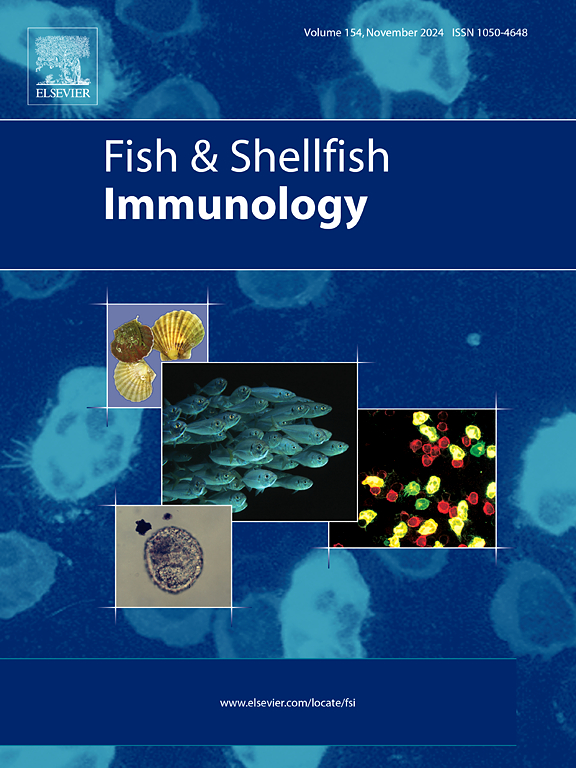红唇鲻鱼(Planiliza haematocheilus)硫氧还蛋白新成员核氧还蛋白(NXN)的分子特征、转录分析和抗氧化活性评估。
IF 4.1
2区 农林科学
Q1 FISHERIES
引用次数: 0
摘要
核氧还蛋白(NXN)是一种重要的氧化还原酶,属于硫氧还蛋白家族,在调节细胞氧化还原稳态中起关键作用。虽然NXN的功能特征已经在哺乳动物中得到了广泛的研究,但它在鱼类中的作用仍然相对未知。在这项研究中,利用硅工具、表达分析和体外实验对haematocheilus Planiliza NXN基因(PhNXN)进行了分子和功能表征。预测的PhNXN蛋白序列包含418个氨基酸,预计分子质量为47.53 kDa。它由一个高度保守的位于中心NXN结构域的188CPPC191催化基序和两个富含保守Cys残基的硫氧还蛋白样结构域组成。PhNXN蛋白主要定位于细胞质和细胞核中。PhNXN mRNA的时空表达分析显示,正常生理条件下,PhNXN mRNA在大脑中的表达水平最高,而在多肌苷、多胞酸、脂多糖和garvieae乳球菌免疫刺激后,在血液和头肾中表达显著调节。重组PhNXN蛋白具有清除DPPH自由基、巯基依赖性二硫还原和铜离子还原活性。此外,PhNXN过表达显著抑制氧化应激诱导的细胞死亡、重金属阳离子诱导的活性氧产生和病毒性出血性败血症病毒诱导的细胞凋亡。此外,PhNXN在RAW 264.7细胞中过表达表现出显著的一氧化氮清除活性、m2型极化和抗炎作用。总之,本研究的总体发现突出了PhNXN在红唇鲻鱼中的抗氧化和免疫功能。本文章由计算机程序翻译,如有差异,请以英文原文为准。
Molecular characterization, transcriptional profiling, and antioxidant activity assessment of nucleoredoxin (NXN) as a novel member of thioredoxin from red-lip mullet (Planiliza haematocheilus)
Nucleoredoxin (NXN) is a prominent oxidoreductase enzyme, classified under the thioredoxin family, and plays a pivotal role in regulating cellular redox homeostasis. Although the functional characterization of NXN has been extensively studied in mammals, its role in fish remains relatively unexplored. In this study, the NXN gene from Planiliza haematocheilus (PhNXN) was molecularly and functionally characterized using in silico tools, expression analyses, and in vitro assays. The predicted protein sequence of PhNXN contained 418 amino acids with an anticipated molecular mass of 47.53 kDa. It comprised a highly conserved 188CPPC191 catalytic motif in the central NXN domain and two thioredoxin-like domains enriched with conserved Cys residues. PhNXN protein was primarily localized in the cytoplasm and nucleus of the cells. The spatial and temporal expression analyses of PhNXN mRNA showed the highest expression level in the brain under normal physiological conditions, while a significant modulation was detected in the blood and head kidney following immunostimulation with polyinosinic: polycytidylic acid, lipopolysaccharides, and Lactococcus garvieae. Recombinant PhNXN protein exhibited DPPH radical scavenging, thiol-dependent disulfide reduction, and cupric ion reduction activities. Additionally, PhNXN overexpression significantly suppressed oxidative stress-induced cell death, heavy metal cation-induced reactive oxygen species production, and viral hemorrhagic septicemia virus-induced cellular apoptosis in fish cells. Furthermore, PhNXN overexpression in RAW 264.7 cells demonstrated notable nitric oxide scavenging activity, M2-type polarization, and anti-inflammatory effect. Collectively, the overall findings of the study highlight the antioxidant and immunological functions of PhNXN in red-lip mullet.
求助全文
通过发布文献求助,成功后即可免费获取论文全文。
去求助
来源期刊

Fish & shellfish immunology
农林科学-海洋与淡水生物学
CiteScore
7.50
自引率
19.10%
发文量
750
审稿时长
68 days
期刊介绍:
Fish and Shellfish Immunology rapidly publishes high-quality, peer-refereed contributions in the expanding fields of fish and shellfish immunology. It presents studies on the basic mechanisms of both the specific and non-specific defense systems, the cells, tissues, and humoral factors involved, their dependence on environmental and intrinsic factors, response to pathogens, response to vaccination, and applied studies on the development of specific vaccines for use in the aquaculture industry.
 求助内容:
求助内容: 应助结果提醒方式:
应助结果提醒方式:


